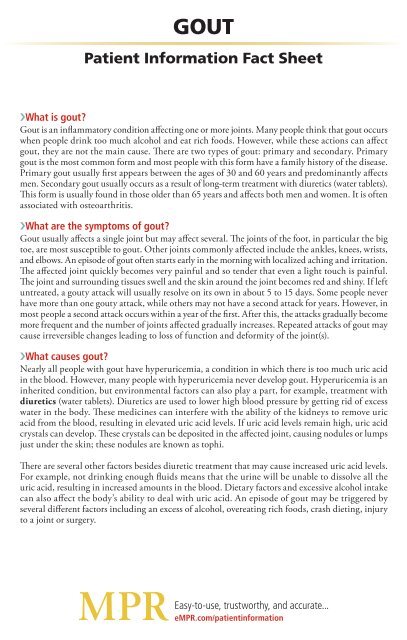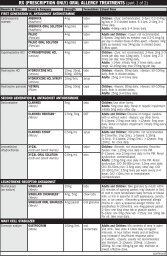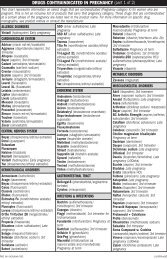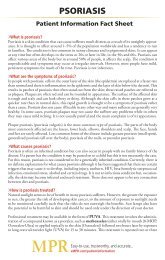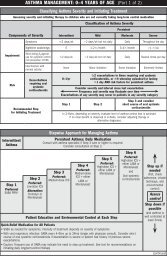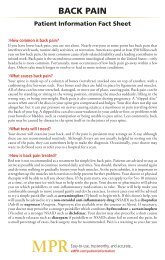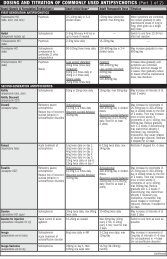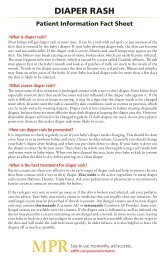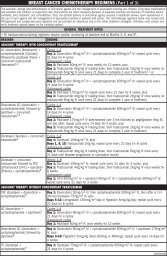Patient Information Fact Sheet - MPR
Patient Information Fact Sheet - MPR
Patient Information Fact Sheet - MPR
Create successful ePaper yourself
Turn your PDF publications into a flip-book with our unique Google optimized e-Paper software.
Gout<strong>Patient</strong> <strong>Information</strong> <strong>Fact</strong> <strong>Sheet</strong>›What is gout?Gout is an inflammatory condition affecting one or more joints. Many people think that gout occurswhen people drink too much alcohol and eat rich foods. However, while these actions can affectgout, they are not the main cause. There are two types of gout: primary and secondary. Primarygout is the most common form and most people with this form have a family history of the disease.Primary gout usually first appears between the ages of 30 and 60 years and predominantly affectsmen. Secondary gout usually occurs as a result of long-term treatment with diuretics (water tablets).This form is usually found in those older than 65 years and affects both men and women. It is oftenassociated with osteoarthritis.›What are the symptoms of gout?Gout usually affects a single joint but may affect several. The joints of the foot, in particular the bigtoe, are most susceptible to gout. Other joints commonly affected include the ankles, knees, wrists,and elbows. An episode of gout often starts early in the morning with localized aching and irritation.The affected joint quickly becomes very painful and so tender that even a light touch is painful.The joint and surrounding tissues swell and the skin around the joint becomes red and shiny. If leftuntreated, a gouty attack will usually resolve on its own in about 5 to 15 days. Some people neverhave more than one gouty attack, while others may not have a second attack for years. However, inmost people a second attack occurs within a year of the first. After this, the attacks gradually becomemore frequent and the number of joints affected gradually increases. Repeated attacks of gout maycause irreversible changes leading to loss of function and deformity of the joint(s).›What causes gout?Nearly all people with gout have hyperuricemia, a condition in which there is too much uric acidin the blood. However, many people with hyperuricemia never develop gout. Hyperuricemia is aninherited condition, but environmental factors can also play a part, for example, treatment withdiuretics (water tablets). Diuretics are used to lower high blood pressure by getting rid of excesswater in the body. These medicines can interfere with the ability of the kidneys to remove uricacid from the blood, resulting in elevated uric acid levels. If uric acid levels remain high, uric acidcrystals can develop. These crystals can be deposited in the affected joint, causing nodules or lumpsjust under the skin; these nodules are known as tophi.There are several other factors besides diuretic treatment that may cause increased uric acid levels.For example, not drinking enough fluids means that the urine will be unable to dissolve all theuric acid, resulting in increased amounts in the blood. Dietary factors and excessive alcohol intakecan also affect the body’s ability to deal with uric acid. An episode of gout may be triggered byseveral different factors including an excess of alcohol, overeating rich foods, crash dieting, injuryto a joint or surgery.Easy-to-use, trustworthy, and accurate...e<strong>MPR</strong>.com/patientinformation
Gout<strong>Patient</strong> <strong>Information</strong> <strong>Fact</strong> <strong>Sheet</strong>page 2›What tests confirm a diagnosis of gout?A blood test can measure the amount of uric acid in the blood. A high level does not necessarilyindicate gout and a normal level does not mean that gout is not present. It does, however, give agood indication. Fluid may be extracted from an affected joint in order to look for uric acid crystals.If it is thought that diet may be a contributing factor, then urine samples can be collected tosee how much uric acid the body is producing. The symptoms of osteoarthritis can be similar tothose of gout and the two conditions often affect the same joints. Tests will usually be performedto determine the actual cause of the condition. It is possible for uric acid crystals to be deposited ina joint that is already affected by osteoarthritis. If this happens it may be difficult to diagnose gout.›How is gout treated?Acute attacks of gout are usually treated with moderately high doses of non-steroidal anti-inflammatorydrugs (NSAIDs). Examples of these include diclofenac (Cataflam, Zipsor), indomethacin,ketoprofen, naproxen (Anaprox), piroxicam (Feldene) and sulindac (Clinoril). These drugs willreduce symptoms of gout such as pain and inflammation of the joint, and should take effect within24 hours of starting therapy. Aspirin should not be used for treating gout. Colchicine (Colcrys) isan anti-gout agent that may be given to treat or prevent an acute attack. Take colchicine at the firstsign of gout flare then 1 hour later. Do not exceed the max dose that can be taken over a 1 hourperiod. In gout prevention the dose can be taken once or twice daily. In chronic (long-lasting) gout,medication can be given to reduce the formation of uric acid. Allopurinol (Aloprim, Zyloprim)and febuxostat (Uloric) reduce the formation of uric acid and are given after an attack to preventrecurrence. These medicines should not be taken during an episode of acute gout as they can prolongthe symptoms. They may need to be taken on a regular basis to prevent further episodes and thedose will be adjusted to a maintenance level according to uric acid levels in the blood.›Self-help measures• Ensure that you drink sufficient fluids to enable your kidneys to flush out uric acid.• Take all medicines regularly as ordered by your doctor. If you buy any medicines for ailmentssuch as colds and the flu make sure they do not interact with your treatment for gout. Ask yourdoctor or pharmacist if you are unsure.• Obesity can affect gout so try to keep your weight at a healthy level.• Avoid drinking too much alcohol as this can raise uric acid levels and trigger an episode of gout.• Avoid foods that are high in purines (eg, anchovies, gravy, sweetbreads, mushrooms, sardines).›Further informationNational Institute of Arthritis and Musculoskeletal and Skin Diseases (NIAMS) <strong>Information</strong>Clearinghouse: http://www.niams.nih.gov/Health_Info/Gout/default.aspLast reviewed: June 2013Easy-to-use, trustworthy, and accurate...e<strong>MPR</strong>.com/patientinformation


